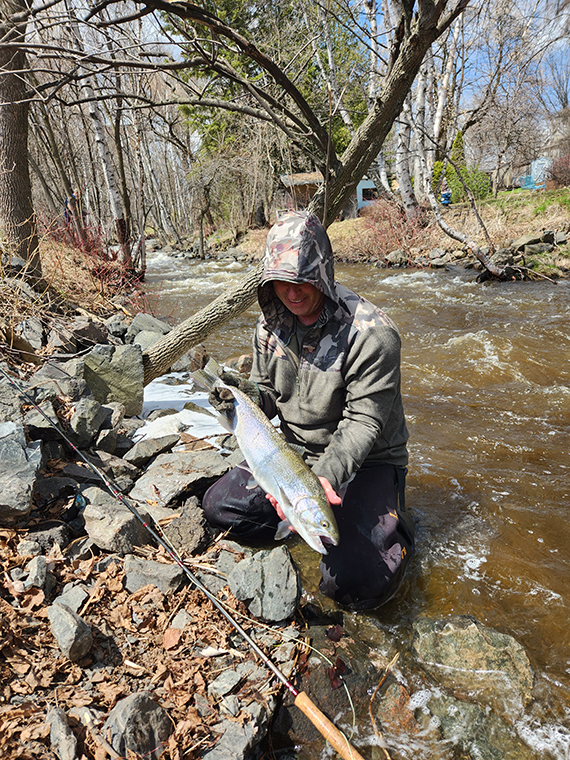
Fishing for steelhead anywhere in Ontario can be quite a challenge.
Variables include timing, which depends on factors such as rain, snowpack, air temperature, moon phase, and God knows what else. Some springs are cold and miserable, making standing on a riverbank uncomfortable at best. Other years, it’s too hot, which also makes standing on a riverbank a drag. Then there are the water levels. When water is high, and when it is low, steelhead fishing becomes challenging in many ways.
Let’s look at how exactly high and low water impacts steelhead fishing and how to compensate in each situation.
High water
There may be nothing more intimidating to the steelhead angler than walking up to a river boiling with water. The water takes on a life of its own, creating back eddies that didn’t exist before, while running through shoreline trees and shrubs. Add in dirty water and the scenario is bleak. However, a wise and seasoned steelhead angler once told me that “high water sucks in fish” and I’ve found that to be true. The problem is getting fish to see and strike your bait. This can be tougher than it sounds.
Where to find the trout
One of the trickiest parts of high-water fishing is sorting where the fish will be holding. Many locations anglers gravitate to in normal flows are simply not fishable — or even distinguishable. High-water anglers need to rethink fish locations. In these conditions, fish seek the slowest possible current. This normally means avoiding the main flow and hugging edges. I’m always amazed at how close to the bank steelhead will run and hold. Instead of trying to fish heavy water in the main part of a river or creek, probe the pockets, runs, and back eddies formed by excess water.
In high water, steelhead will also hold at the tail-outs of pools, where the water breaks off into rapids. This tail-out water is not always deep, but the current is slower there and that makes it easier for the trout to hold.
The bellies of deep runs and pools will also have slower water than what is churning overhead. Trout will hold tight to bottom until it’s time to move upstream. In other instances, they may be in spawning mode and will wait until water begins to drop to set up. Getting to the deeper fish in heavy water can be tricky. Let’s discuss that next.
How to fish high water
The hardest part of fishing for steelhead in high water (besides actually finding them) is putting a presentation in front of their face. Fast, high water is hard to punch through. A fly, roe bag, or most lures just fly across the surface, caught in the high-speed flow. There are other options, however.
Bounce a dropper rig: Drift fishing anglers can use a dropper rig with either egg sinkers or a slinky rig. The weight must be heavier than normal to punch through the surface and get down to bottom. While egg sinkers pinched onto a mono dropper are the simplest set up, a slinky rig is the most snag-proof. The rig should be heavy enough to bounce along bottom, but not get constantly snagged. This can be a trying way to fish until you find the right balance. Use a drift rod that can handle the extra weight of the presentation and hold any fish that hits. A medium to medium/heavy graphite rod of eight to 10 feet should do it.
For full details on bottom bouncing, click here
Dropper rig under a float: In larger runs and pools, use a large slip float to suspend a slinky/dropper rig. The slip float will be on the large side, due to the weight of the presentation and current speed. I’ve had great success with pike/dead bait-sized slip floats. They tend to be longer, larger, and brighter than a typical steelhead/trout-sized slip float.
Adjust the slip float stop on the line somewhere that allows the rig to touch bottom, so you don’t get snagged. Once you find that sweet spot, snags are rare and when that float disappears, you can be confident that a steelhead is on the other end.
Lures: Large, deep pools are a prime situation for a Mepps #3 Aglia, EGB spoon, or #7 Rapala Shad Rap — work them through the tail-water area or deep pool. Cast the lure across the river and then slowly let it swing through with the current, allowing the lure to flutter, dive, or spin naturally. Slowly reeling the lure will keep the line tight and action consistent. Other options in deep pools are a hair jig, tube, or twister cast upstream and allowed to drift with the current.
Make sure the jig is moving with a soft, swimming motion as it slips through the current. Jigs with orange, chartreuse, red, or pink in them will get the most attention.
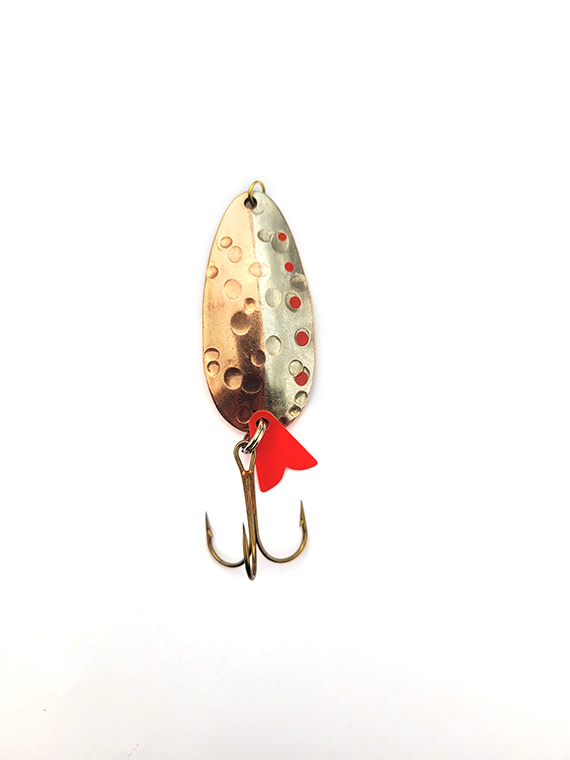
Strikes on a lure will be savage in a fast flow. Use terminal tackle that’s up to the task.
Low water
When river and creeks are running low, the game really changes. Steelhead are a large fish and spend most of their adulthood in the wide-open spaces of the Great Lakes. When they return to a river or stream after years in big water, they will be on guard. Low water greatly amplifies their nervousness. The smaller the waterbody, the more liable fish are to be spooked.
Where to find the trout
The good thing about low water is that nearly all fish-holding structure is visible. For example, a large boulder that was hidden by regular water levels now peeks above the surface. Pools, runs, and riffles are obvious.
Steelhead, despite being big, can vanish in even the smallest creeks. They’ll tuck into the sides of boulders, or under a bank, disappearing like magic.
If you have not invested in high-quality polarized sunglasses, this is when you need them. You will always be looking for fish in low water. Not that you will always see them, as deeper pools and runs can still hide them. Yet, an angler that doesn’t carefully scan water they want to fish stands a very high chance of spooking fish. Most steelhead in low water will hang out in pools, runs, holes, and undercuts that provide cover. An overhead tree or two is a bonus.
How to fish low water
All this is to say that fishing for steelhead in low water is nearly always a finesse game. Even larger rivers with low water will find steelhead nervous and often suffering lock jaw.
Drift a single bead: Where you might drift a roe bag in high or regular water a single egg is best in the skinny flows. A flashy chartreuse-and-orange yarn fly is great in high water but will be replaced by a nymph pattern or single orange bead when levels are low.
Add a float: Although I find floats less effective in low water, they certainly play a role in still water and long pools. Floats should be subtle and small. Clear or very light-coloured floats will be key in low water. A “fixed” float on the leader is usually the best in low water as depths are minimal. Use just enough weight to cock the float properly, but not drag bottom.
Lures: Although it might seem like low water and lure fishing cannot coexist, the opposite is true. Low water fish often react well to small, subtle lures. I’ve personally had great luck with small Colorado blade spinners with minimal weight. At times, you can use a weightless spinner, although in deeper water you might need to add a split shot or two. Other spinners, including the Mepps Aglia, Panther Martin, and EGB spinner can all work, but use the lightest ones. Same goes with spoons: go small, light, and subtle in low water. A big, heavy spoon tossed into shallow pool will scatter steelhead like shotgun pellets.
One excellent low-water lure is a small Flatfish or Kwikfish. These have a slow, enticing wobble that doesn’t seem to spook trout. In low water, get to the top of a run and feed it slowly down stream. A long rod will help you get that lure where you want it without casting a shadow. A split shot or two often helps keep the wobbler down. Slowly let line out and hold the lure for a moment or two. Then let more line out and hold. Strikes will be hard.
Steelhead are awesome fish and always worth the effort it can sometimes take to connect. Use these techniques to catch fish in whatever water challenges mother nature doles out.
Ghost trout
At one time in my life, I spent many days fishing creeks on Lake Superior’s St. Ignace island. All the creeks were clear and relatively low. We would usually cast to fish we could see — trout hiding under a log, tree, or undercut. Barring that, they would be positioned headfirst in the riffles, or at the bottom of pools where water was barely moving. I can’t tell you how many times I’d throw a yarn fly into a pool that looked empty, and have a trout materialize and grab it.
Steelhead are masters at disappearing in unlikely places. So, tread lightly.
Stay stealthy
- Approach a spot from upstream.
- Wear drab coloured clothing.
- Watch your shadow. A long shadow cast across a pool can spook low-water trout.
Story time
Some small pools and pockets can concentrate fish when the water is up. One spring, a local river near my Thunder Bay home was incredibly high. I could hear the falls roaring from inside my truck, 600 metres away. This high water created some interesting pockets along the river edges. In normal flow, these didn’t exist or were too shallow to fish.
I dropped a roe bag and slinky (a DIY snag-resistant sinker) on a slip float and let it spin in the pocket. I dropped the rig in and could tell the roe bag was dragging near bottom. The float made one-and-a-half circles, then vanished. I set the hook and a silver-sheened steelhead vaulted into the air before tearing off downstream. Unfortunately, physics was not on my side and the hook pulled out. A couple more fish were hooked in that little back eddy, however, and I finally managed to land one. Not the prettiest way to catch a steelhead, but on that day, it felt like a win.
Originally published in the Spring 2024 issue of Ontario OUT of DOORS


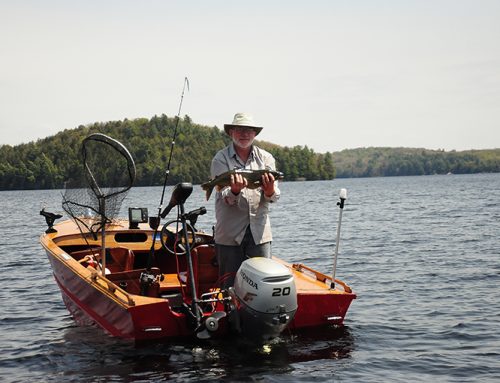
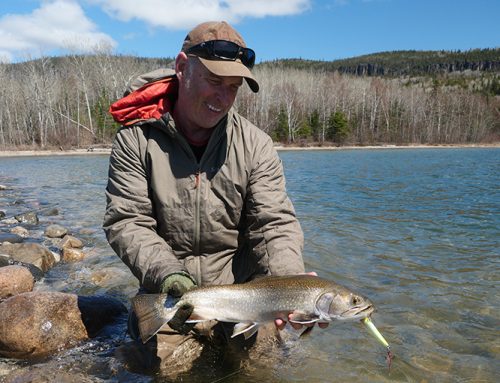
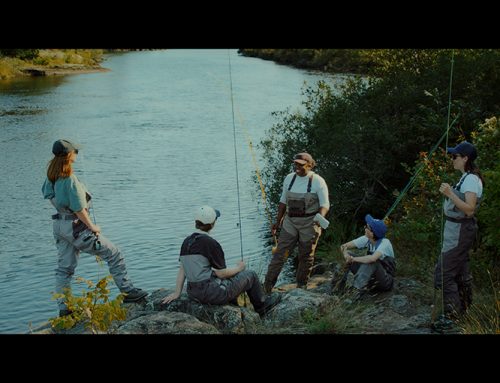

Leave A Comment